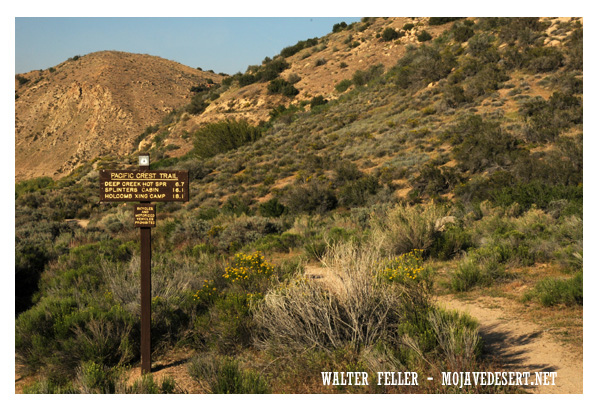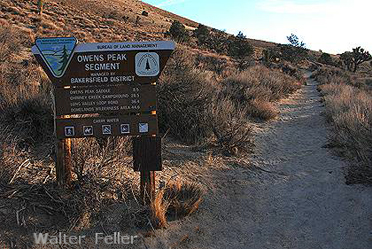--
Pacific Crest Trail

Southern California Segment
Length - 648 Miles. The trail is generally snow-free by April-MayBorder to San Gorgonio Pass
The PCT begins on a low hill near Campo (elev. 2,600’), a small town near the Mexican border. It passes through Lake Morena County Park and beneath Interstate 8, then climbs through chaparral, scrub oaks, and pines to the rim of the Laguna Mountains. The trail dips into Anza-Borrego Desert State Park at Scissors Crossing, then winds up, down, and around the San Felipe Hills and lesser mountains of the Cleveland National Forest before crossing Highway 74 at 4,900’ and climbing the backbone of the San Jacinto Mountains. It reaches its highest point in this section at 9,030’ shortly before it plunges to its lowest, crossing beneath Interstate 10 at elev. 1,190’ in broad San Gorgonio Pass.
San Gorgonio Pass to Western Mojave Desert
From here, the PCT climbs steeply to the crest of two east/west-oriented ranges, often under welcome forest shade. It passes near Big Bear Lake and Lake Arrowhead before crossing Interstate 15 between the San Bernardino and San Gabriel Mountains at Cajon Pass near Silverwood Lake State Recreation Area. The vistas from the trail in these mountains include the Los Angeles Basin and Mojave Desert. To the west of Mt. Baden-Powell and the Angeles Crest National Scenic Byway, it descends to Highway 14 at Agua Dulce, then traverses the often brushy landscape of the Sierra Pelona. It continues north for a generally hot and dry traverse across the San Andreas Fault Zone and the western arm of the Mojave Desert before climbing into the Tehachapi Mountains where it crosses Highway 58 and enters the Sierra Nevada.
Western Mojave Desert to Walker Pass
The Southern California section ends where the trail crosses Highway 178 at Walker Pass (elev. 5,246’). The mountains of this section are bounded by and internally laced with faults that have been active in recent geologic time. The animals in this section include lizards, rodents, snakes, coyotes, and cougars. Colorful and quick, hummingbirds can also be seen darting about, gathering nectar. The plants here are generally desert scrub, chaparral, or oak, with forests only at the higher elevations. Trail-side water is scarce in this section, particularly in the summertime, when temperatures range from the 80s to the low 100s.
source - USFS
Pacific Crest Trail Photos
San Bernardino National Forest
Angeles National Forest
-
Wrightwood - Cajon
Grassy Hollow - Wrightwood
Vincent Gap - Mt Baden-Powell
Mt Islip - Cloudburst
Cloudburst - Aliso Springs
Along the Pacific Crest Trail
-
Vasquez Rocks
Lamil Springs
Limber Pines
Mt Baden-Powell Peak
Vincent's Cabin
Wrightwood
Lost Lake
Cajon Pass
Mormon Rocks
Silverwood Lake
Lake Adelaide
Deep Creek Hot Springs
